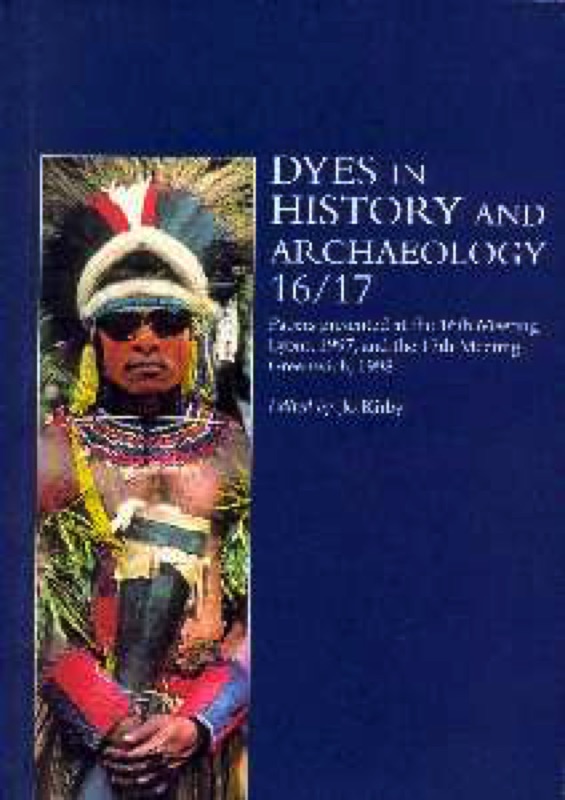Interest in all aspects of dyestuffs has grown considerably since an informal meeting of researchers twenty years ago developed into the annual meetings of Dyes in History and Archaeology, with the journal of the same name publishing a selection of papers presented.
Analysis has revealed that the early 20th-century clothing and textile designer, Mariano Fortuny, used natural dyes for his glorious silks and cottons. Natural indigo is still used in some parts of the world, but dyeing with it is harder, less pleasant work than is popularly supposed. Species of Coleus - one of which is the flame nettle, a popular houseplant in the West - are used as sources of red, blue, purple and green dyes in Papua New Guinea and other parts of Asia. Research into the history of dyestuffs covers many disciplines and their chemistry is also of fundamental interest: the development of synthetic dyes was a breakthrough for chemical technology and industrial processes, and analysis has enabled the dyestuffs used on historical textiles and in pigments used in paintings to be identified.
These topics were among those presented at the 16th meeting, held in Lyons in 1997, and the 17th meeting, held in Greenwich, London in 1998, and discussed in the papers included in this book. They reveal the variety of disciplines with a common interest in this fascinating, colourful world.
Editorial
Contributors
Addenda
Plant Dyes: from archaeology to industry
Patrick Brenac, Emmanuelle Beaur, Patrick Choisy and Anne De La Sayette
Yellow dyes of historical importance. III. New historical and chemical evidence on a wild Mediterranean dye-plant
Daphne gnidium, Dominique Cardon and Claude Andary
The technology of silk dyeing by cochineal. II. The experimental investigation of the influences of types and concentrations of cations
Valery Golikov
The technology of silk dyeing by cochineal. III. The influences of pH, water quality, cream of tartar and oak galls
Valery Golikov
Synthetic alizarin - the dye that changed history
Alan Dronsfield, Trevor Brown and Christopher Cooksey
Mariano Fortuny (1871-1949): his use of natural dyes
Frances Pritchard
Traditional recipes for natural dyeing of wool in the south of Tunisia
Naceur Ayed and Abir Alatrache
Colorants used in the material culture of Papua New Guinea
Rowena Hill
Dyeing with indigo and mud in Senegal and Mali
Jenny Balfour-Paul
The last indigo dyer in Tunisia: technology and quality control
Abir Alatrache and Naceur Ayed
Indigo and the 40 robbers: romantic transfigurations of the blue-printer's trade in modern society
Georg Stark
Revival of biblical Tekhelet dyeing with banded dye-murex (Phyllonotus trunculus): chemical anomalies
Dr Irving I. Ziderman
Chemical studies on Nucella lapillus
Christopber Cooksey and Robert Withnall
The synthesis and properties of 6-bromoindigo: indigo blue or Tyrian purple? The effect of physical state on the colours of indigo and bromoindigos
Christopher Cooksey
The microbiology of the medieval woad vat (poster presentation)
A. Nikki Padden, Vivian M. Dillon, John Edmonds, M. David Collins, Nerea Alvarez and Philip John
Dye analyses using derivative UV-visible spectrophotometry and fibre-safe extraction with EDTA
Recep Karadag and Harald Bohmer
Orchid lichens of Tunisia: chromatographic identification and dyeing system
Tijani Karmous and Naceur Ayed
The possibility of differentiation and identification of red and blue 'soluble' dyewoods: determination of species used in dyeing and chemistry of their dyestuffs
Witold Nowik
The Dye of Rubia peregrina. I. Preliminary investigations
Jan Wouters
A successful Talmudic-flavored high-performance liquid chromatographic analysis of carthamin from red safflower dyeings
Zvi C. Koren
Preliminary research into lac lake pigments using HPLC/electrospray mass spectrometry
Raymond White and Jo Kirby
Development of analytical techniques for the study of natural yellow dyes in historic textiles
Ester S.B. Ferreira, Anita Quye, Hamish McNab, Alison N. Hulme, Dr Jan Wouters and Jaap J. Boon
Analysis of natural organic pigments by laser desorption mass spectrometry (LDMS): a preliminary study to spatially resolved mass spectrometry
Nicolas Wyplosz, Ron M.A. Heeren, Gerard van Rooij and Jaap J. Boon
The colouring of alum-tawed skins on late medieval books
Cheryl Porter
Influence of fungicides and insecticides on colour materials
Oliver Hahn
Degradation of artefacts caused by iron-containing dyes
Vincent Daniels
Recent publications concerning the analysis and history of dyes: abstracts of books and papers received since 1997
Compiled by Penelope Walton Rogers
Index to papers
Reviews
This work provides conservators with valuable information and insight into textile dyeing...This book has a little of something for everyone: conservators specializing in books, textiles, objects, and ethnographic materials, as well as conservation scientists, curators, and people interested in technology. This variety is almost certainly a result of the diverse backgrounds of the authors: dyers, historians, conservators,chemists, biologists, and curators, all united by their interest in traditional dyestuffs. The other striking aspect of the book is its truly international scope, in terms of both topics covered and the nationalities of the authors. Clearly there is world-wide interest in the history and anlysis of dyestuffs, and it is encouraging to see the interdisciplinary approach taken in so many of the articles.
Journal of the American Institute for Conservation 41(3) (2002) 302-304
On [Penelope Walton Roger's] retirement following publication of the papers from the 15th meeting a new publisher and editor were called for and these two attractive and excellently edited volumes are the first results.
Studies in Conservation 47(4) (2002) 278-280
